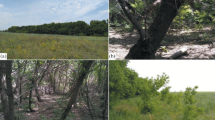Abstract
The Spruce Pamphilid, Cephalcia abietis L., a pest dangerous to young and old spruce stands in Austria
Continous of the spruce, fir and beech growth area on ranges in the northeast (from 1966 onwards) and southwest (from 1970 onwards) of the Waldviertel (Lower Austria) have shown that in connection with other unfavorable effects (rime) this species can become a dangerous pest. In areas reforested with apruce - on clearing which have resulted from feeding -already in the year of reforestation and in the following one eggs were deposited. Feeding took place on old needles and on needles of the May shoots. Retrogradation began after two stages of eruption on the southern and after one on the northern elevations. It was found out that by unfavorable environmental condition emergence of 200 imagines per sqm to obvious and even high losses. In initial populations of the same feeding period in which increases of populations by migration did not take place, generations of 1, 2, 3 and 4 years could be proved. Factors of the biotic environment resistance (parasitic insects, bacteria, fungi) have been of importance for the reduction of young larvae in the soil only in the third year of retrogradation: in the second year virus diseases have caused in the southwest considerable dying of the young larvae in the crowns.
Phosphorus insecticides, applied with ULV-methods, killed 50–80% of the young larvae. Lindan was used with success for the treatment of forestations.
Similar content being viewed by others
Literaturverzeichnis
Donaubauer, E., 1959: Über eine Mykose der Latenzlarve vonCephaleia abietis L. Sydowia. Ann. MycologiciII (XII), 181–222.
Escherich, K., 1942: Die Forstinsekten Mitteleuropas. 5. Bd. 746 S. Verl.: P. Parey Berlin.
Hequist, K. J., 1956: Studien über die größere Fichtengespinstblattwespe und deren Auftreten in Skåne (Schwedisch). Meded. Stat. Skogsforskninginst.46, 1–54.
Jahn, E., 1962: Beobachtungen zu einer Schlaffsuchterkrankung der Fichtengespinstblaftwespe,Lyda hypotrophica Htg. (Cephaleia abietis L.) im Latenzstadium und während der Fraßperiode in den Kronen. Anz. Schädlingsk. 35, 99–102.
Jahn, E., 1973: Hinweise zur Auswirkung biophysikalischer Umweltverhältnisse auf forstschädliche Insekten, untersucht insbesondere anLymantria monacha L. Anz. Schädlingsk., Pflanzen- u. Umweltschutz56, 37–43.
Kalandra, A., 1961: Verlauf der Massenvermehrung der gemeinen GespinstblattwespeCephaleia abietis L. im Erzgebirge in den Jahren 1950–1960. Commun. inst. forest. Čechosloveniae2, 173–176.
Kalandra, A., 1963 a: Beitrag zum Verlauf der Gradation der gemeinen FichtengespinstblattwesoeCephalcia abietis L. im Forstrevier Sedloňov bei Náchod in den Jahren 1952–1960 (tschechisch). Lesnický Časopis9, (XXXVI), 15–22.
Kalandra, A., 1963 b: Ein Beitrag zur Gradologie der Fichten-Gespinst-BlattwespeCephalcia abietis L. im Adlergebirge in den Jahren 1950–1960. Commun. inst. forest Čechosloveniae3, 47–52.
Martinek, V., 1961: Dauer des Überliegens der GespinstblattwespenCephaleia abietis L. u.C. arvensis Panz. im Erzgebirge (tschechisch) Lesnictví7 (XXXIV), 653–677.
Mayer, R. H.;J. Eckhart;J. Nather;W. Rachoy u.K. Zukrigl, 1971: Waldgebiete und Wuchsbezirke Österreichs. Cbl. ges. Forstwirtsch.88, 129–164.
Schimitschek, E., 1950: Forstschutzkalender. F. J. Kwizda Wien-Korneuburg 61 S.
Schimitschek, E., 1952: Über die Poyederkrankheit der FichtengespinstblattwespeLydia hypotrophica Htg. (Cephaleia abietis L.) Mitt. Forstl. Vers. Anst. Mariabrunn47, 70–73.
Schwerdtfeger, F., 1970: Die Waldkrankheiten. Ein Lehrbuch der Forstpathologie und des Forstschutzes. Verl.: P. Parey, Hamburg u. Berlin, 509 S.
Author information
Authors and Affiliations
Rights and permissions
About this article
Cite this article
Jahn, E. Die Fichtengespinstblattwespe, Cephalcia abietis L., als gefährlicher Bestandes- und Kulturschädling in Österreich. Anz. Schadlingskde., Pflanzenschutz, Umweltschutz 49, 145–149 (1976). https://doi.org/10.1007/BF01984837
Issue Date:
DOI: https://doi.org/10.1007/BF01984837




